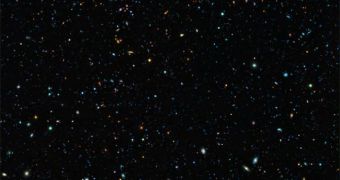Performing a census of all galaxies is one of the trickiest challenges in astronomy today. Not only do researchers have to look deep into the heart of the Universe, and observe structures that were formed just a billion years after the Big Bang, but they also need to keep an eye out for obscured structures, which generally do not show up in surveys. This happens for a variety of reasons, ranging from the fact that they are obscured by light from other celestial object, to insufficient performances on the part of the observatory conducting the study, Space reports.
In fact, scientists estimate that most of the censuses performed to date, which set the foundation for the galactic surveys that are regularly used for a variety of other studies, miss out on a lot of galaxies. It is believed that about 90 percent of existing structures of this kind are omitted as the investigations are conducted. “If there are 10 galaxies seen, there could be a hundred there,” says astronomer Matthew Hayes, who is based in Switzerland, at the University of Geneva Observatory. He was also the leader of the study that made the finding.
The expert reveals that the situation deteriorates more the further the observation targets are from Earth. While it's relatively simple to identify galaxies close to the Milky Way – and even to analyze them thoroughly – doing the same thing for structures located billions of light-years away is tremendously difficult. One of the most commonly-used methods of detecting distant galaxies is looking for the Lyman-alpha line, which is basically a rather thin range of wavelengths emitted by hydrogen gas within galaxies. However, many have criticized this method for its inaccuracy. In many instances, critics say, it may be that the target galaxy itself blocks this radiation, basically rendering the entire structure invisible to even the most advanced ground- and space-based telescopes.
“Astronomers always knew they were missing some fraction of the galaxies in Lyman-alpha surveys, but for the first time we now have a measurement. The number of missed galaxies is substantial,” Hayes reveals. “Now that we know how much light we've been missing, we can start to create far more accurate representations of the cosmos, understanding better how quickly stars have formed at different times in the life of the Universe,” adds Centro de Astrobiologia (CSIC-INTA) expert Miguel Mas-Hesse, a coauthor of the investigation.
To come to these conclusions, Hayes and his team conducted a series of astronomical observations using the European Southern Observatory's (ESO) Very Large Telescope (VLT), in Chile. They relied on readings collected by the FORS and HAWK-I cameras on the instrument for their conclusions. Details of the work appear in the March 25 issue of the esteemed scientific publication Nature.

 14 DAY TRIAL //
14 DAY TRIAL //